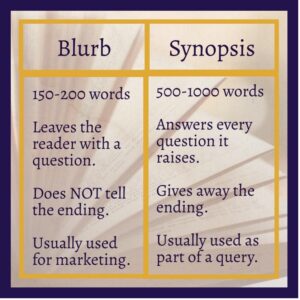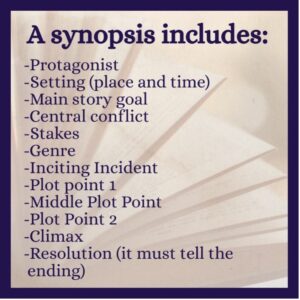
A synopsis is one of those things that authors—especially those who plan to query agents and publishers—need, but usually hate to write. But learning how to write a book synopsis is something that is worth the time and attention you invest. Even if you intend to publish independently, a synopsis can come in handy.
Before we delve into how to what a synopsis is and how to write one, we need to first cover the difference between a blurb and a synopsis.
The Difference Between a Blurb and a Book Synopsis
Though they are both summaries of a story, a blurb and a synopsis are not the same thing. Let’s look at the similarities and differences between the two.
What Is a Blurb?
Both book blurbs and synopses need to introduce the protagonist, the story world, the main story goal, the central conflict, and what’s at stake. However, that is really all they have in common.
A book blurb averages between 150 to 200 words, though this can vary somewhat according to the genre. A synopsis, on the other hand, averages between 1 to 2 pages, or 500 to 1000 words, but can vary according to the submission guidelines of the agent, editor, or publishing house you are querying.
Finally, a book blurb should leave the reader with a question, the answer to which they will want to read the book to find out. A synopsis will tell the ending of the story. This is because a blurb is most often used as marketing copy to drive sales of the book, whereas a synopsis is meant to act as proof that you have a solid story arc and a complete and compelling story worth investing in.

To find out more about what blurbs include and how to write them, check out the article What is a Book Blurb on the Fictionary blog.
What is a Book Synopsis
A book synopsis is a 1-to-2-page summary that gives all of the main, central information to agents, publishers, and editors. As mentioned above, it will introduce the protagonist, the story world, the main story goal, the central conflict, the stakes, and the genre. This will tell agents and editors whether or not you have a realistic (within the parameters of the genre) yet compelling story idea that is worth investing in.
If you intend to self-publish, it is still worthwhile to create a synopsis since having this information will tell you, as the author, if your story idea is strong and compelling or if there are areas where it is lacking.
In addition to this information, though, a synopsis has to include all of the main plot points of the narrative arc, in chronological order. This includes the inciting incident, plot point 1, the middle plot point, plot point 2, the climax, and the resolution—yes, the synopsis needs to tell the ending and not hold anything back. In doing so, you are letting editors, agents, and publishers (and yourself) know that you have a solid story arc and a story that works.

How Long Is a Synopsis?
A synopsis should be approximately one page long. Depending on the size of your font, this will place it between 450 and 700 words.
Because a synopsis is so short, you need to ensure your words are concise and that every word pulls its weight. Let’s cover this in a little more detail.
How to Write a Synopsis for a Novel
Now that you know the basics of a synopsis, what can you do to make that simple synopsis great? Opinions vary, of course, but here are some things I believe will take your synopsis to the next level.
- Start with a compelling hook. While a synopsis isn’t used for marketing purposes like a blurb, you still want to get your readers’ attention. If you are querying an editor, agent, or publisher, you want your story to stand out among the other submissions. Do this by starting your synopsis with 1 to 3 strong sentences that are unusual or attention-grabbing.
- Include a well-crafted, descriptive overview and/or introductory paragraph. I say ‘and/or’ here because not everyone will need to write both an overview and an introductory paragraph. However, if your story requires a lot of world-building—like fantasy, sci-fi, dystopian, or historical fiction—then you might need the extra space.I write fantasy, so I like to include both. My overview paragraph is like a blurb that includes the ending, but that doesn’t give a comparative statement or call-to-action. I start it with an attention-grabbing hook and include the protagonist, the setting, the story goal, the central conflict, the stakes, the genre, and the ending. In the rest of the synopsis, I expand on what was written in the overview.In the next paragraph, the ‘introductory’ paragraph, I show the protagonist in their ordinary world. This gives more space for introducing the main character and their world. I try to do this in a way that will allow readers to relate to the protagonist and to have enough understanding of her world to know what she stands to lose should she not achieve the story goal.
- Use emotion to draw readers into the story. Yes, the synopsis gives a plot summary, but it should not do so in a boring, mechanical way. You don’t want to overdo it with flowery, emotional words and images since this is part of a professional query. However, you want that agent or publisher you’re querying to see that your story can get and keep reader attention, making it worthwhile for them to invest their time and money.

Tips for How to Write a Book Synopsis
- Check out submission guidelines before you send in your synopsis. The required length of a synopsis can vary. Be sure to check out the guidelines of the agent or publisher beforehand. Some will only read up to the word limit, and you also want to show them you respect their time and have done your research.I suggest having a couple of versions of your synopsis on hand so you are prepared.
- Mirror the tone of the book in your synopsis. In other words, if you’re writing a light romantic comedy, don’t make the synopsis heavy and formal. If you are writing a dark fantasy or a thriller, don’t tell jokes or be too flippant.Writing your synopsis in the same tone as your book will give the editor, agent, or publisher a feel for your book and your voice.
- Start with an outline of a sentence or two per plot point, then expand from there. Instead of trying to figure out how to summarize a 90,000-word book into 500 words, I find it much less daunting to write a sentence or two for each plot point, and then fill in details that are essential for understanding and that show your creativity and voice.
- Write in the third person, present tense. Do this even if the book isn’t written in that POV or tense. This lends immediacy to the action, and it is also more professional.
To learn more about book synopsis and how to write them, check out the article How to Write a Book Synopsis on the Fictionary blog
Writing a Synopsis for a Novel Conclusion
A synopsis is an important, professional summary of your story intended for querying agents and publishers. That doesn’t mean, however, that it should be stiff and mechanical. You want the people you are querying to get a sense of your voice, the tone of the book, and it’s creativity and appeal.
Start with the essential parts of a synopsis then fill in details (up to the word limit) using creative, image- and emotion-evoking words and phrases. And don’t forget, even if you aren’t querying, writing a synopsis will let you know if you have a solid story and story arc and show you areas you might need to improve.

